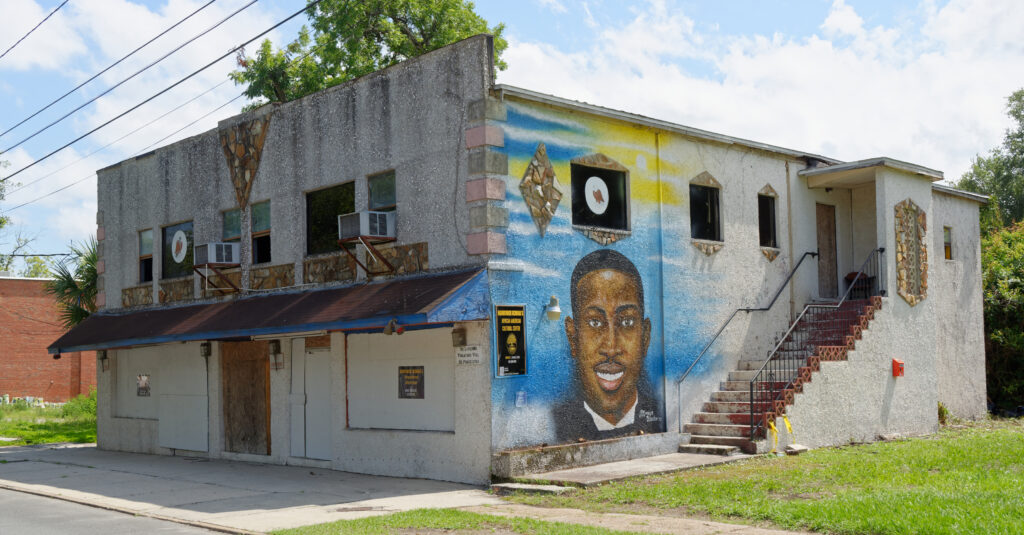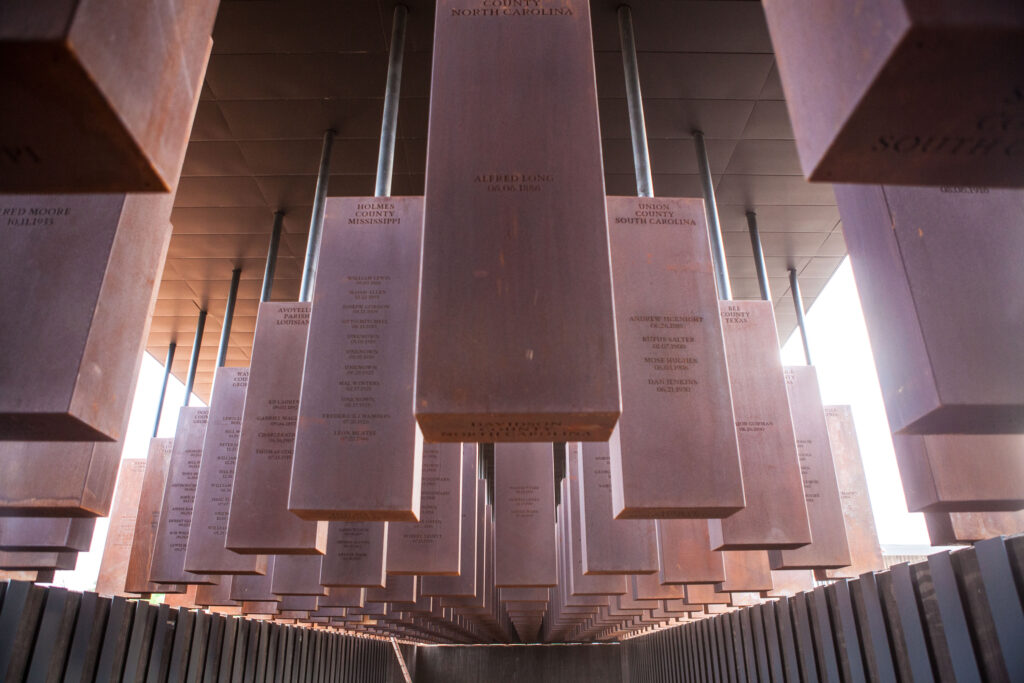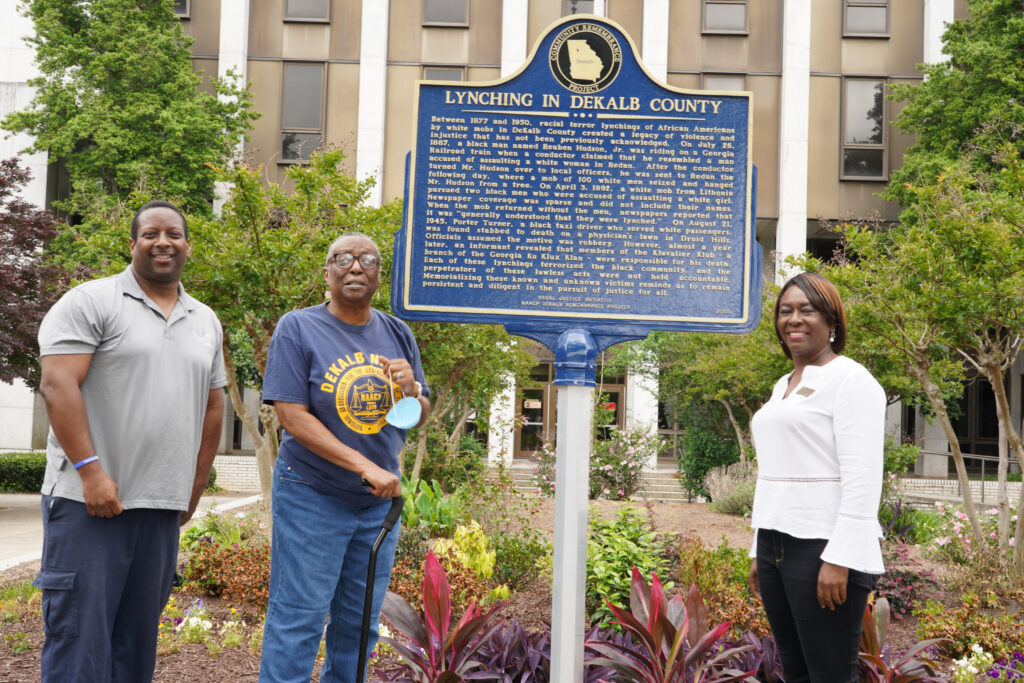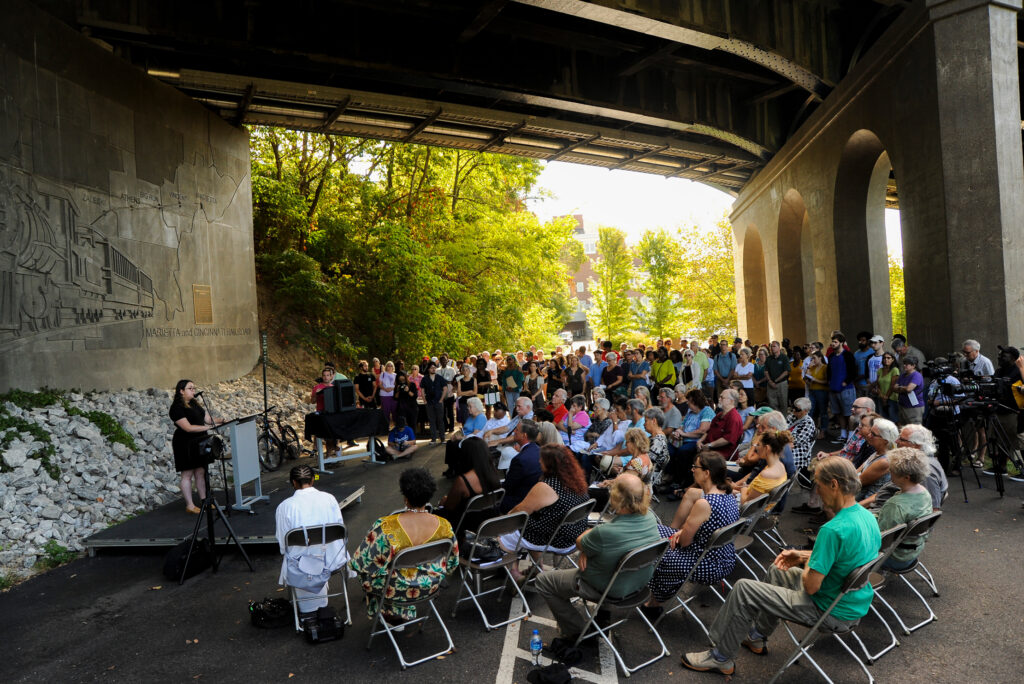
A mural memorializing Ahmaud Arbery by artist Marvin Weeks painted on the building that will become the Brunswick African American Cultural Center at 1621 Albany Street. Photo by Jud McCranie/Wikimedia Commons.
A mural of a smiling Black boy wearing a tuxedo spans the side of a two-story building constructed in the 1950s out of concrete and oyster shells. His face is imposed on top of splashes of blue and gold. The building, located at 1621 Albany Street, Brunswick, Georgia, was neglected for two decades, with past lives as a nightclub and a cultural center. But due to the tragic fate of the mural’s subject, Ahmaud Arbery, it’s now poised to become a community hub once again: the Brunswick African American Cultural Center. Painted by Brunswick-bred artist Marvin Weeks, the mural signifies hope in the small coastal city still reeling from the February 23, 2020 killing of 25-year-old Arbery by a mob of white vigilantes, nine miles away from the old tabby building.
As a little Black girl coming of age in Brunswick in the 1990s and 2000s, I would’ve never dreamed that a modern-day lynching in my hometown would catalyze uprisings across the globe, but that’s precisely what the killing of Arbery manifested. Growing up, teachers ignored the Confederate flag-emblazoned t-shirts worn by some of my classmates. A store in our local mall called Dixie Outfitters proudly displayed its Confederate apparel.
Racist symbols in Brunswick are just beginning to be seriously challenged. As recently as 2018, the Brunswick News covered the annual Confederate Memorial Day celebration at a 20-foot tall white stone monument in the city’s historic downtown, installed by mourning daughters of the Confederacy in 1902. Four months after Arbery’s death, the monument was spray painted in two different spots with the acronym “BLM.”
BLM. Black Lives Matter. These messages have irrevocably shifted society and culture by igniting worldwide movements to attain liberation for Black people after centuries of suffering from police and state violence. The omnipresence of BLM is so great that even the most conservative of cities (i.e., Brunswick) are being forced to reckon with systemic and institutional racism, along with symbols of white supremacy. The refrain has been painted on the street in front of the White House and Trump Tower in New York City, among myriad other places. Meanwhile, statues of colonizers and slave owners are rapidly being removed, by law and by force. Christopher Columbus statues are having a particularly rough year.
It’s clear that communities are ready to envision what and who should be commemorated in public spaces in lieu of reminders of hate.
In Montgomery, Alabama, one can experience the fruits of such visioning labor at the Memorial for Peace and Justice, colloquially referred to as the “lynching memorial,” which opened in 2018. Having a lynching memorial in the U.S. is painful yet necessary, since there’s no end in sight to this horrific act. The memorial covers six acres on top of a hill and overlooks a downtown boasting a statue of Jefferson Davis, the sole president of the Confederacy. It’s a project of the human rights nonprofit, Equal Justice Initiative (EJI)—an accompaniment to their cultural institution less than a mile away, the Legacy Museum: From Enslavement to Mass Incarceration, housed in a warehouse where slave traders once imprisoned Africans before selling them at auctions.

The 800 suspended steel monuments at EJI’s National Memorial for Peace and Justice in Montgomery, Alabama list the names of the more than 4,000 documented Black victims of lynching in the United States between 1877 and 1950. Image courtesy of Human Pictures/Wikimedia Commons.
At the memorial, visitors interact with text and narratives intended to convey the horrors of the state-sanctioned violence that has plagued Black people in the U.S. for hundreds of years. Sculpture, art, and design are incorporated into the memorial to “contextualize racial terror.” EJI founder and Executive Director, Bryan Stevenson, conceived of the design with his team of attorneys and a host of collaborating artists.
As you head towards the memorial, a giant open-sided pavilion, you encounter a scene of bronze figures sculpted by Ghanaian artist, Kwame Akoto-Bamfo. The sculpture depicts a group of shackled Black people whose bodies are contorted in distress. A baby cries at their mother’s breast. On the far side of the pavilion is another sobering piece, this one by American conceptual artist, Hank Willis Thomas. The bronze sculpture evokes the too familiar sight of Black people with their hands stretched to the sky in surrender. Entitled Raise Up, the piece embodies the popular rallying cry, “Hands up, don’t shoot!”
Once inside the pavilion, you witness a visual ode to the more than 4,000 Black victims of lynching in the U.S. between 1877 and 1950. 800 corten steel monuments are suspended from the ceiling of the pavilion and standing upright, each one representing a county where a racial terror lynching occurred, engraved with the names of victims. The words of Montgomery’s own, Dr. Martin Luther King, Jr., along with a quote from Toni Morrison’s novel, Beloved, and Elizabeth Alexander’s poem, “Invocation,” are featured throughout.
“Your names were never lost, each name a holy word,” the first line of Alexander’s poem reads.
This memorial is hallowed ground that ensures Black lynching victims’ names won’t be lost, but rather preserved, remembered, and honored. In a field to the side of the pavilion lies 800 monuments identical to the ones inside the memorial, inviting visitors to publicly remember these injustices in their own communities. Individual counties can claim a replica of these monuments by engaging in EJI’s Community Remembrance Project.
The Community Remembrance Project partners with countywide community coalitions committed to steeping themselves in work that creates “greater awareness and understanding about racial terror lynchings” and begins “a necessary conversation that advances truth and reconciliation.” Communities find out about the project via EJI’s museum, memorial, and website or through word of mouth. EJI puts those who express interest in creating a coalition and who are from the same communities in touch with one another. Once a coalition is formed, EJI and the coalition work in tandem to tell the true story of racial terror lynchings in the given county through the Community Historical Marker Project, the Community Soil Collection Project, and broader community education and engagement. All of the coalitions are moving towards claiming their county’s corten steel monument to racial terror lynchings and erecting it in their communities.
As someone who’s been organizing in the South for almost a decade, I’ve admired EJI’s work for some time. I spoke with representatives from some of these coalitions, and their emotions were palpable. During these conversations, I couldn’t help but think of my hometown, where remembering in public for Arbery is well underway, but lynchings of the past have long been forgotten.
“We started to turn it from a project to a journey.”
– Teresa Hardy, NAACP DeKalb Remembrance Project Coalition
A journey was born from a NAACP DeKalb County Branch trip in summer 2018, when they traveled 160 miles southwest from DeKalb County, Georgia to the EJI memorial and Legacy Museum. During the ride home, the group decided to unveil their community’s history of racial terror lynchings with the Community Remembrance Project. On September 18, 2019, inside the DeKalb History Center in downtown Decatur, Georgia, with a 30-foot Confederate monument outside, the NAACP DeKalb Remembrance Project Coalition orchestrated their Interfaith Reconciliation Service.

Historical marker producer, Troy Vincent (left), Community Remembrance Project Chair, Dee Smith (center), and NAACP DeKalb President, Teresa Hardy (right), with a recently installed lynching marker. Photo by Albert Fields.
About 200 community members gathered at the ceremony, where coalition chairperson, D.E. Smith, shared the stories of the three known lynchings in DeKalb County to an aghast crowd. In attendance were five relatives of Porter Turner, a Black taxi driver murdered by the Ku Klux Klan in 1945. At the end of the service, a “call to commitment” was issued to attendees to engage in the coalition’s work, mainly their “Journey of Remembrance and Reconciliation.”
NAACP DeKalb President, Teresa Hardy, told me the Interfaith Reconciliation Service marked the beginning of a series of forums and discussions on racial healing.
“The Black people didn’t really want to talk about lynching, and the white people didn’t really want to talk about it, and then when you do, there could be this anger about the whole thing, so how do we get past all of this? We know our history. Let’s know our history, understand our history, and do better from what we know,” Hardy remarked.
Since its inception, the coalition has grown to more than 50 community members and organizations. Not even the COVID-19 pandemic has stopped it from reaching milestones. In May, with research support and sponsorship from EJI, the coalition installed their first historical marker outside of DeKalb City Hall, sadly without the fanfare they’d originally planned due to the pandemic (they hope to have a dedication ceremony before September). Like the rest of EJI’s markers, their marker is an “Alamo”-shaped plaque affixed on a pole that bears the history of the documented racial terror lynchings in their county. Two more are planned for the cities of Lithonia and Redan in DeKalb County.
Only a month after the marker installation, the group saw their labors bear more fruit. They’d been part of a years-long movement to take down the Confederate memorial in downtown Decatur, which the city finally did by court order on the night of June 18th, to thunderous applause. The significance of the monument’s removal on the eve of Juneteenth, a holiday honoring the last enslaved Black people in the U.S. to learn of the Emancipation Proclamation, wasn’t lost on the coalition.
“I’ve found it a real blessing to have the opportunity to work with some of the people I’ve worked with.”
– Susan Righi, Christopher Davis Community Remembrance Project
Athens County, Ohio has a vastly different racial landscape from DeKalb County, Georgia. According to the U.S. Census Bureau, the latter is 54.8 percent Black, while the former is 2.8 percent Black. Both Black spaces and Black history in Athens, Ohio have been neglected over the years, but there are concerted efforts to recover and preserve them.
The community has discovered Black history in its very soil. On September 14, 2019, more than 300 people gathered to collect soil near the site where a 24-year-old Black farm laborer named Christopher Davis was lynched in 1881 for allegedly assaulting a white female acquaintance. Speakers from the community and EJI shared remarks, and an Ohio University (OU) Master’s student in acting, Kezia Waters, channeled Davis’ narrative in a brief monologue, with a noose around his neck.
“For months [I] feared trouble was coming on me,” Davis wrote to his wife while awaiting trial for his alleged wrongdoing. As a Black person doing well for himself, Davis was a natural target for racial violence, so his ominous words are unsurprising. The local newspaper reported that its own editor was a part of the mob who broke into Davis’ jail cell, put a noose on him, dragged him to the South Bridge over the Hocking River, and hung him. While the bridge is long gone, the base of it has been recovered and is now owned by OU.
Susan Righi, coordinator of the Christopher Davis Community Remembrance Project, gets chills when reading the story of Davis’ lynching. She choked up while recalling it for me. Righi helped assemble the project, a coalition of people and organizations committed to justice for Black lives in Athens, including Ada Woodson Adams, a genealogist who’s been a keeper of Black history in the region for decades, and the Mount Zion Baptist Church Preservation Society, a group dedicated to rehabilitating a historic Black church.
Righi told me the project has been a good opportunity for white and Black people to band together for racial justice.
“With the recent events and more police killings coming to light, I think this has helped people understand that this racial violence we’re seeing perpetrated against Black people is not the result of bad apples. It’s not some kind of new phenomenon, it’s just part of a long continuum,” Righi said.

With support from EJI, the Christopher Davis Community Remembrance Project organizes a soil collection ceremony with community members to memorialize Davis, a Black farm laborer lynched in 1881. Photo courtesy of the group.
Soil collected at the September ceremony was sent to be displayed at the EJI museum and memorial. In June, the project collaborated with EJI to install a historical marker with the account of Davis’ lynching near where it occurred that will make it impossible for Black history in Athens to be buried again. A dedication ceremony for the marker is planned for later this year.
“People need to know that these things happened. They should not be ignored.”
– Jacqueline Hubbard, Esq., Pinellas County Community Remembrance Project Coalition
The Pinellas County Community Remembrance Project Coalition is planning their own historical marker dedication ceremony for this November to coincide with the 106th anniversary of the lynching of John Evans, a Black man accused of murdering a prominent local resident and assaulting the man’s wife in St. Petersburg, Florida. In front of a crowd of at least 1,500, Evans was hung from a light post, where he clung for dear life before being riddled by bullets. The marker will be installed at the site of his lynching at Dr. Martin Luther King, Jr. Boulevard (formerly 9th Street South) and Second Avenue South.
The coalition formed to commemorate this racial terror lynching, in addition to two others, has swelled to 83 members from various ethnic and faith backgrounds since early 2019. Prior to the pandemic, the group met twice a month at St. Augustine’s Episcopal Church in St. Petersburg, one of the oldest historically Black churches in the state. I spoke with a member of their congregation, Jacqueline Hubbard, a retired attorney who serves as a co-chair of the coalition. Hubbard was disturbed by what she saw working within the criminal legal system. In 2018, she and other members of her local chapter of the Association for the Study of African American Life and History traveled to Montgomery to experience EJI’s museum and memorial, which inspired them to answer the organization’s call to participate in “restorative truth-telling.”
Bearing witness to the legacy of racial terror epitomized by lynchings in America is the coalition’s mission. Their goals include advocating for the truth of a story; educating with the truth of the story; and commemorating and collating the history of racial terror lynchings in Pinellas County in an effort to bring about reconciliation, justice, equity, peace, and healing.
Hubbard thinks this work is crucial because the general public lacks knowledge and awareness of what African Americans have suffered, from slavery times to the current era of mass incarceration.
“People would come to see lynchings as if it were a barbecue or a picnic, and they would watch a Black person being literally tortured to death in crowds of people, mostly white, who watched these horrific acts of violence,” Hubbard explained.
Though the coalition’s marker isn’t up yet, Hubbard said their message is already reverberating around the county. People from all walks of life are finally talking about the community’s history of lynching Black people, a solid step towards racial reconciliation.
——————
I couldn’t write about a lynching memorial project without recalling victims of racial terror lynchings in my own hometown. Their lives still matter, and we must remember them if we claim to be invested in racial justice.
Ahmaud Arbery, a fellow graduate of Brunswick High School, who was cornered by three white men in a subdivision, then shot to death by the one with whom I shared a class in ninth grade.
Henry Jackson and Wesley Lewis, who were given time to pray before having ropes tied around their necks and being shot dead by a mob of 300 men in February 1891.
The eight Black men shot and killed in July 1947 at the now closed Anguilla prison camp after refusing to wade into a snake-infested swamp without their boots on.
The Confederate memorial in Brunswick was spray painted around the same time as multiple protests and widespread calls for its removal in Arbery’s name, spurring the city commission to appoint a nine-member committee to decide on its future. The committee represents a broad range of perspectives, including a life member of the Sons of Confederate Veterans, a member of a local women’s advocacy group, a local history professor, and the pastor of a Black Baptist Church.
I suspect the newly formed committee will weigh options similar to ones being considered across the country. Perhaps the monument will end up being displayed in a museum. Maybe it will end up in storage indefinitely. It’s possible that it will remain right where it is in the heart of downtown. As the process unfolds, I’m praying this symbol of hate is replaced by one that remembers victims of racial violence in the same vein as the Community Remembrance Project.
Neesha Powell-Twagirumukiza is a Southern storyteller who conspires in the name of liberated Black futures, queer and transgender Black/Indigenous/people of color power, solidarity economics, transformative justice, and community accountability. Powell-Twagirumukiza’s writing has been published in various online and print publications, including Autostraddle, Bitch, Prism, Rewire.News, Scalawag, VICE, YES Magazine!, and Monday: the Journal of the Jacob Lawrence Gallery. They are a MFA in Creative Writing candidate at Georgia College & State University and graduated from the University of Georgia with a B.A. in Journalism & Mass Communication. Tweet with Neesha @womanistbae.


